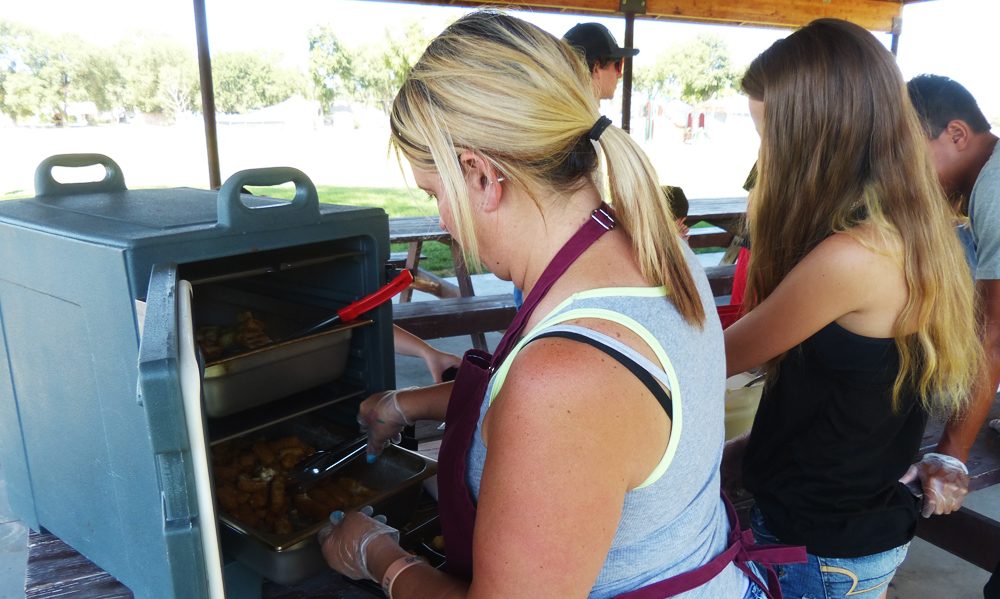 Volunteers serve up fish sticks as part of a free lunch at Wadleigh Park in Vale on Monday, July 23. (The Enterprise/Carolyn Agrimis)
Volunteers serve up fish sticks as part of a free lunch at Wadleigh Park in Vale on Monday, July 23. (The Enterprise/Carolyn Agrimis)
VALE – Children in Malheur County are almost twice as likely to be living in poverty compared to the rest of the state, according to recently released numbers.
The Annie E. Casey Foundation released its annual report on state poverty levels, ranking Oregon at 30th in the United States with 17 percent of Oregon kids listed as living in poverty.
Malheur County’s child poverty rate in 2017 was 34 percent, according to Children First for Oregon, a nonprofit that works to improve the lives of Oregon children.
There were 7,733 kids ages 0-17 in Malheur County in 2017, with the county’s total population being 30,439.
“People think we have a problem with poverty but the problem isn’t just with being poor or a lack of programs or services,” said Kelly Poe, Director of Community Based Services in the Malheur Education Service District.
Poe noted a lack of good jobs and affordable housing in Ontario and the rest of Malheur County as reasons why the rate of child poverty is so high.
The border came up in multiple conversations about Malheur County’s child poverty rate.
“The border issue is just something that we have to deal with,” said Barb Higinbotham, executive director of Community in Action in Ontario. “We are spending a lot of our money on people who don’t live here, and of course we are grateful for the traffic but we have to figure out how to keep up with expenses.”
“There’s a huge lack of housing, affordable and attainable housing,” said Higinbotham on why some people live in Idaho but work in areas like Ontario.
“We have families who are living in poverty conditions…houses that are not really habitable by our housing standards,” she said of the housing situation in Ontario. “Unfortunately families are forced to manage whatever way they can.”
“Malheur county has had child poverty over 25 percent for as long as I remember, we kind of bounce between 34 and 36 percent,” said Poe. “Baker and Wallowa, their poverty rates aren’t quite as bad.”
Baker County’s child poverty rate was listed as 27 percent and Wallowa County’s was 26.2 in Children First For Oregon’s 2017 report.
“Jobs, housing, food insecurity…those things are not new,” said Poe of Malheur County’s rate. “The only thing that we can claim is different is the Idaho border which makes it difficult to compete in business, especially in Ontario where it’s probably the most difficult and Nyssa also being right on the border. The community infrastructure doesn’t have the tax base to support the services it needs for the community.”
Over the past few years, Poe has been working on action plans with Baker, Malheur, and Wallowa counties to create stronger communities where residents are encouraged to voice what improvements they think their areas need. These action plans are focused around identifying values that bind people in these communities together and then creating ‘gracious spaces’ where citizens can unite over these values.
Much of the work that Poe does in the three counties revolves around highlighting those who are often overlooked by the community, the people who are represented by the numbers in reports like the one released recently.
“The people we are often doing the work for are often not included, the people who don’t have a voice,” said Poe.
She listed foster children, undocumented individuals, and refugees in the community as some of the people who are left out of the conversations dictating their wants and needs.
Poe said that there tends to be a large difference between what the numbers suggest versus the way people in the community actually feel.
“We really try to work with the folks in community where they’re at and try to figure out what their gaps and their needs are to move them up on the continuum,” said Higinbotham.
Higinbotham said that her agency tries to help people address basic needs like shelter and housing.
Working with community members to address these larger issues is something that both Poe and Higinbotham noted as the key to driving down childhood poverty.
“We have really smart people that live here, I think we have really caring people,” said Poe. “I think when people are willing to let go of that mentality of scarcity and come together, we can really make a difference.”
Carolyn Agrimis: [email protected] or 541-473-3377.




